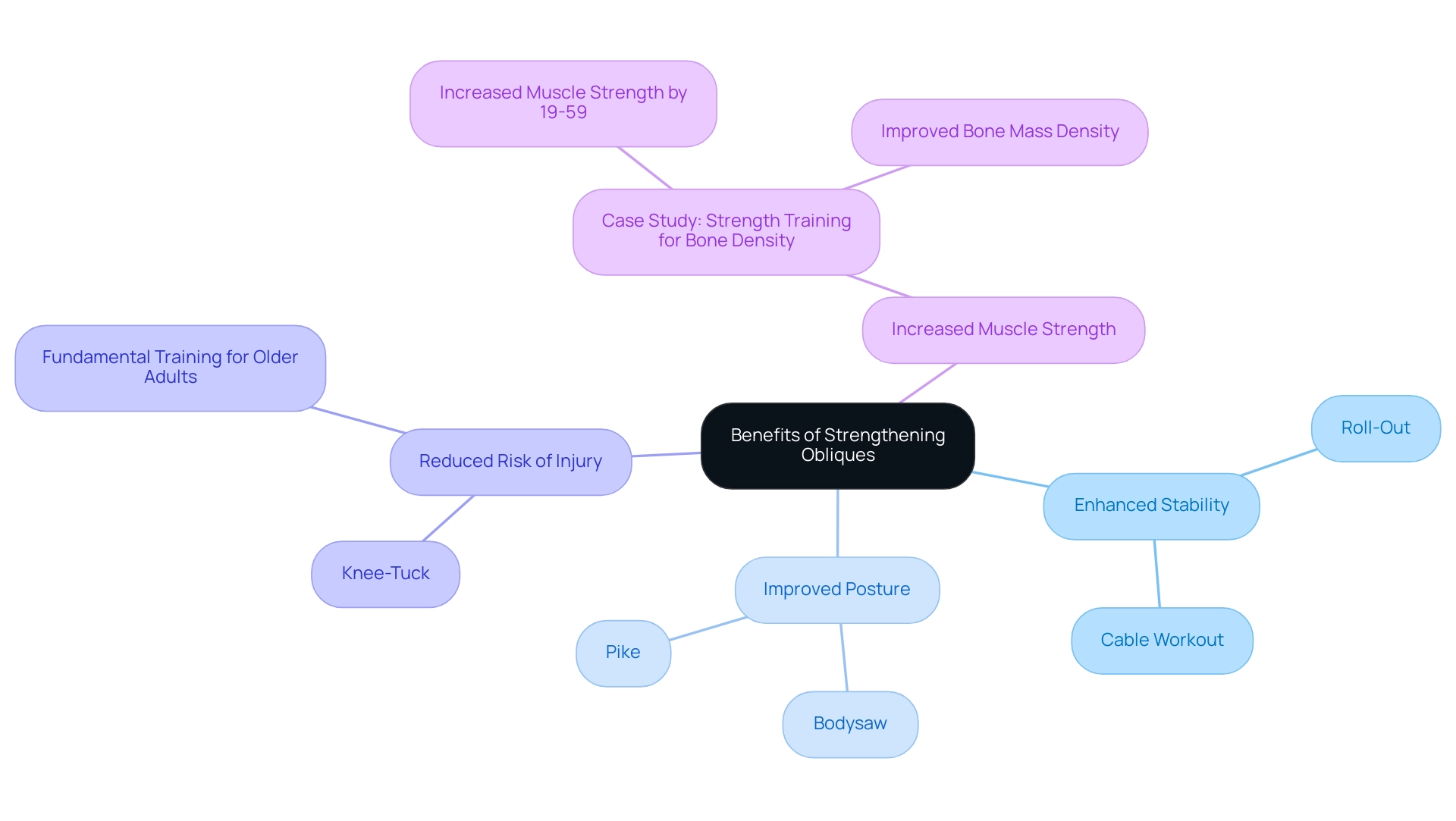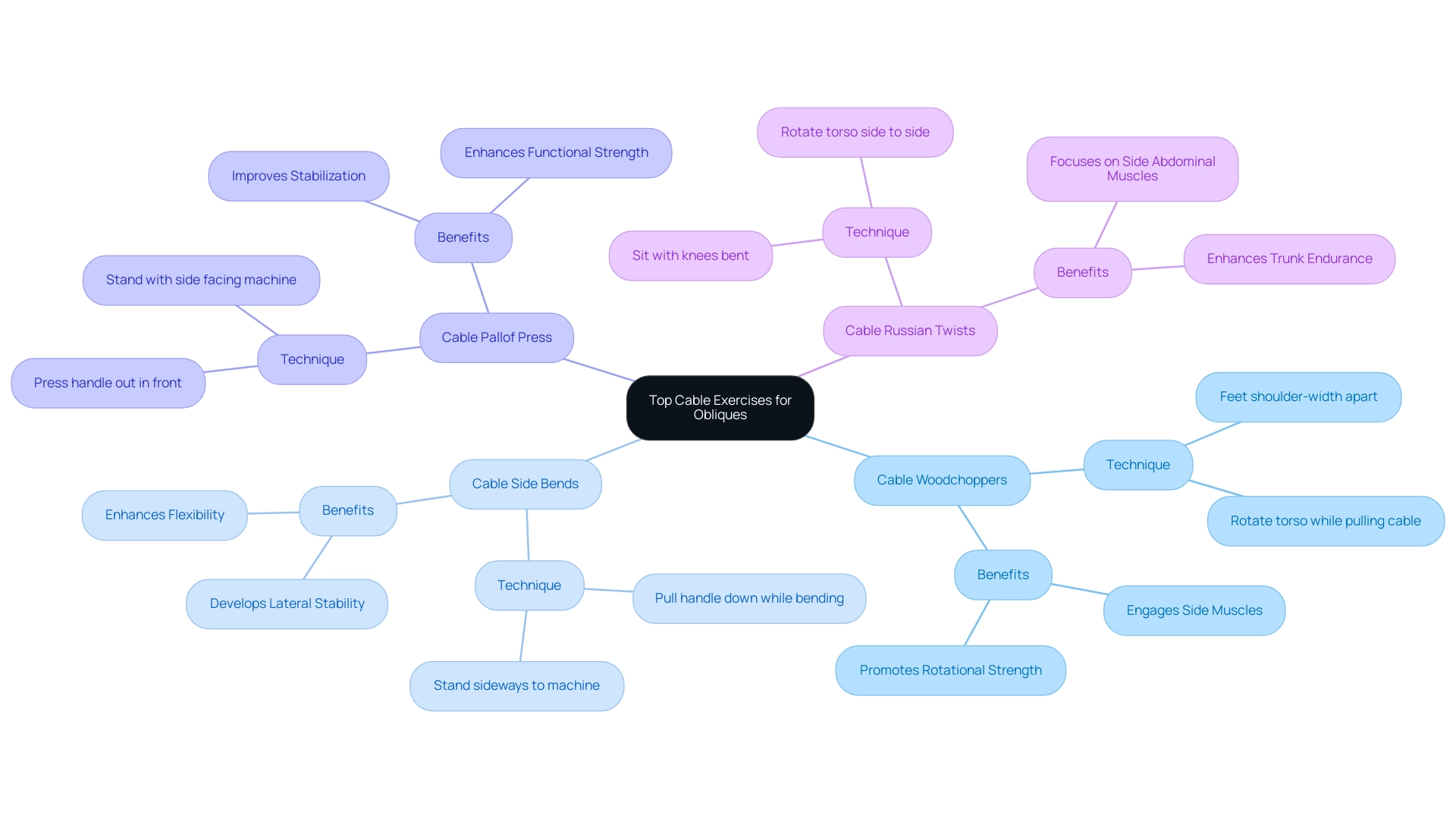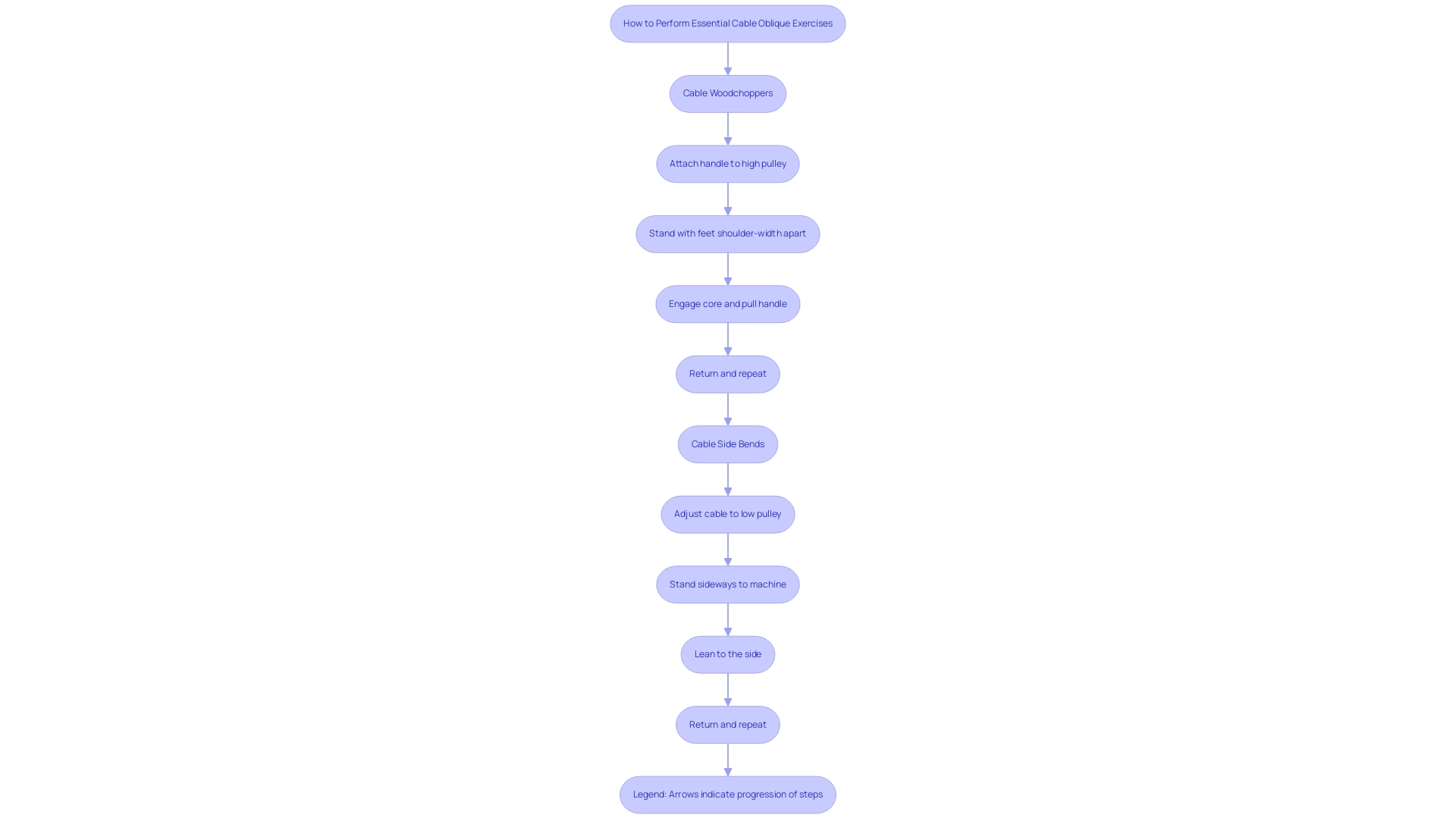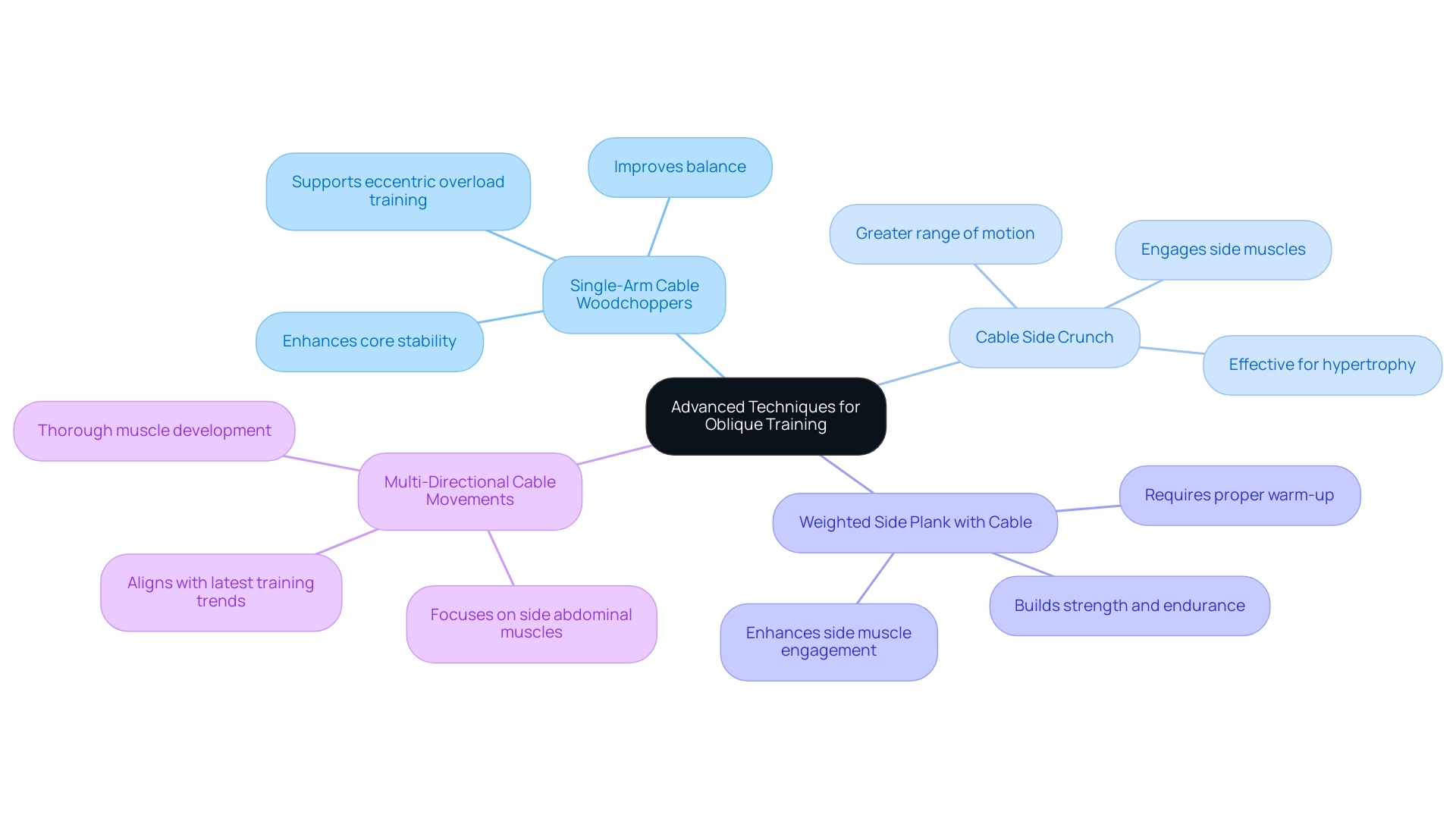Overview
The article focuses on providing a comprehensive tutorial on oblique cable workouts, detailing techniques and tips to enhance effectiveness and prevent injuries. It emphasizes that strengthening the oblique muscles through targeted exercises not only improves core stability and athletic performance but also highlights the importance of proper form, weight selection, and integrating variety into workout routines to maximize benefits and reduce injury risks.
Introduction
In the realm of fitness, the importance of core strength cannot be overstated, and at the heart of this lies the often-overlooked oblique muscles. These vital components of the abdominal structure play a pivotal role in trunk rotation, lateral flexion, and overall core stability, making them essential not only for athletes but for anyone seeking to enhance their physical capabilities.
As the understanding of these muscles deepens, so does the recognition of the risks associated with oblique injuries, particularly in high-performance sports. This article delves into the anatomy and function of the obliques, the myriad benefits of strengthening them, and effective training techniques, including advanced cable exercises designed to maximize engagement and performance.
From avoiding common pitfalls to incorporating variety in workouts, the insights presented here illuminate the path to achieving a robust and resilient core, essential for optimal athletic performance and everyday activities.
Understanding Oblique Muscles: Anatomy and Function
The slanted muscles, comprising the external slants, internal slants, and transverse abdominis, are strategically positioned on the sides of the abdomen. These muscles are crucial for trunk rotation and lateral flexion, significantly contributing to core stability. A strong group of lateral muscles not only supports posture but also reduces risk of harm, thereby enhancing athletic performance through improved stability during dynamic movements.
Recent studies indicate that oblique traumas remain a considerable concern in professional baseball, with a mean time of 20.2 months between initial and subsequent occurrences, underscoring the long-term impact of these issues. Shuro Komatsu from the Institute for Integrated Sports Medicine notes that a mean time of 27.7 days was needed to return to play after an accident. Furthermore, a case study titled 'Effect of Treatment on Recovery Time' highlights that conditions treated with injections resulted in longer recovery times, suggesting that such treatments should be used cautiously.
Understanding the anatomy and function of these muscles, alongside acknowledging potential conflicts of interest related to research support and consulting fees, is vital for effective training and injury prevention strategies. The evidence indicates that well-trained side muscles are crucial in maintaining body stability, which is vital for optimal athletic performance.

The Benefits of Strengthening Your Obliques
An oblique cable workout helps in strengthening the obliques, offering a wealth of benefits that extend beyond aesthetics. Enhanced stability of the body is essential for athletes, especially in sports that demand rotational strength, like golf and tennis. Furthermore, fundamental training is especially effective for older adults at risk of falling, as it helps build stability and confidence, reducing the fear of injury.
A recent study on strength training revealed that targeted activities, particularly the roll-out, have been identified as the most challenging for abdominal muscles, followed closely by bodysaw, pike, and knee-tuck movements. Sarah Walls, a personal trainer and owner of Strength & Performance Training, Inc., emphasizes that,
You get a lot of these fundamental exercises where there’s no spinal movement — or very little — depending on what you’re doing.
This emphasizes the significance of concentrating on stability to improve overall strength.
Moreover, performing an oblique cable workout contributes to better posture, which is essential not only for athletic performance but also for daily activities. A strong center can dramatically reduce the risk of lower back pain and injuries, facilitating a more active lifestyle. The exercise protocol includes executing each movement three times for six seconds, with three minutes of rest between activities, ensuring effective engagement of the abdominal muscles.
As we look toward 2024, the advantages of enhancing side muscles for core stability and athletic performance remain evident, supported by a case study on strength training for individuals with early-onset rheumatoid arthritis, which showed increased muscle strength by 19-59% and improved bone mass density. This highlights the crucial emphasis on angled strengthening for fitness enthusiasts and professionals alike.

Top Cable Exercises for Targeting Obliques
For individuals aiming to improve their lateral strength, here are some top cable routines that effectively focus on these muscles:
- Cable Woodchoppers: Position yourself with feet shoulder-width apart, grasping a cable handle with both hands. Rotate your torso while pulling the cable across your body, simulating a chopping motion. This exercise not only engages the side muscles but also promotes rotational strength, essential for various athletic activities.
- Cable Side Bends: Attach a handle to the high pulley and stand sideways to the machine. Pull the handle down while bending to the side, fully engaging your obliques. This movement assists in developing lateral stability and flexibility.
- Cable Pallof Press: Stand with your side facing the cable machine, ensuring the cable is at chest height. Hold the handle with both hands and press it out in front of you, resisting the urge to rotate. This is a potent activity for stabilization and is especially advantageous for improving functional strength.
- Cable Russian Twists: Sit on the floor with your knees bent and hold a cable handle. Rotate your torso from side to side, keeping your abdomen engaged throughout the movement. This dynamic activity effectively focuses on the side abdominal muscles while enhancing overall trunk endurance.
Furthermore, adding twisting leg raises to your routine can boost side muscle engagement. EMG analyses, as noted in the study by McGill & Marshall (2012), demonstrate superior engagement of the obliques with twisting leg raises compared to traditional leg raises, with participants showing an average age of 25.60 ± 3.40 years. By varying your routines with an oblique cable workout, you can attain a comprehensive training regimen that enhances stability and strength.
As stated by Katelyn Tocci, RRCA + UESCA Certified Running Coach, 'Integrating a range of abdominal routines, including oblique cable workouts, is crucial for building a solid base that enhances overall fitness and prevents injuries.' These exercises can be especially advantageous in workplace wellness initiatives, motivating employees to participate in effective strengthening routines that improve their overall health and productivity.

How to Perform Essential Cable Oblique Exercises
To effectively perform cable woodchoppers, follow these steps:
- Attach a handle to the high pulley of the cable machine.
- Stand with your feet shoulder-width apart, gripping the handle with both hands, ensuring a firm stance.
- Engage your core and pull the cable handle down towards your opposite hip while rotating your torso, focusing on the engagement of your obliques.
- Return to the starting position in a controlled manner and repeat for 10-15 repetitions on each side.
For cable side bends, adhere to the following instructions:
- Adjust the cable to a low pulley position.
- Stand sideways to the machine, grasping the handle with one hand while keeping your feet firmly planted.
- Gently lean to the side, bringing your rib cage towards your hip to enhance side muscle engagement.
- Return to the initial position with control and repeat for 10-15 repetitions on each side.
As Jeremy Ethier highlights, effective side muscle training relies on choosing an oblique cable workout that corresponds with the diagonal alignment of lateral fibers, ensuring that both functionality and form are prioritized. This is supported by the statistic that suggests performing cable fly variations at 3 sets of 8 to 10 reps per arm, which reflects common practices in fitness routines. Additionally, foundational exercises like the Goblet Squat can challenge the side muscles, demonstrating the importance of integrating various movements, such as the oblique cable workout, for comprehensive core training.

Avoiding Common Mistakes: Tips for Effective Oblique Workouts
Avoiding common mistakes during the oblique cable workout is crucial for maximizing effectiveness and reducing risk. Here are key pitfalls to watch out for:
-
Using Excessive Weight: It's vital to prioritize form over the amount of weight lifted.
Overloading can lead to poor technique and significantly heighten the risk of harm. A case study on common causes of fitness equipment injuries highlights that improper use, particularly through excessive weight, is a leading contributor to activity-related injuries, emphasizing the importance of appropriate weight selection.
-
Neglecting Central Engagement: Activating the central muscles is essential for effectively engaging the oblique muscles during an oblique cable workout.
Without appropriate central activation, the effectiveness of the activity decreases, and the chance of strain rises. As noted by Tamires Cibeli Biberg e Silva, the prevalence of low back pain among CrossFit practitioners is higher than that in the general population, underscoring the importance of core stability during intense workouts.
-
Rushing Through Reps: Controlling your movement is key.
Rapid repetitions not only decrease the effectiveness of the exercise but also increase the likelihood of harm. A study on musculoskeletal injuries among weightlifters confirmed that the weight carried while lifting is significantly associated with the occurrence of harm. This suggests that a slower, more deliberate approach is safer and more beneficial, as rushing can exacerbate the risk of injury.
-
Ignoring Flexibility: Flexibility plays a critical role in preventing tightness and strain in the side muscles.
Incorporating stretching and mobility work into your routine can enhance your overall performance and reduce the likelihood of injury. Regular flexibility training is essential for maintaining a healthy range of motion, which is vital for effective side exercises.
By being mindful of these common mistakes and implementing these solutions, you can enhance the safety and effectiveness of your oblique cable workout.

Incorporating Variety: Advanced Techniques for Oblique Training
To enhance the effectiveness and variety of your training, it's essential to incorporate advanced techniques into your oblique cable workout that challenge your center in multiple ways. Consider these activities:
- Single-Arm Cable Woodchoppers: This movement not only enhances core stability but also demands greater balance, making it a dynamic addition to your routine. As Jeremy Ethier emphasizes, effective side workouts should include exercises that align with the diagonal orientation of the side fibers. Research, including findings from Walker 2016, supports the use of eccentric overload training, which has shown significant increases in muscle thickness, reinforcing the effectiveness of such exercises.
- Cable Side Crunch: Utilizing a low pulley for this standing side crunch allows for a greater range of motion. As you bring your knee towards your elbow, you actively engage your side muscles, reinforcing strength and stability. The overall analysis of hypertrophy measurements indicated no difference between ADV and TRAD (SMD = -0.00), suggesting that variations in technique can still yield effective results.
- Weighted Side Plank with Cable: By integrating a cable machine for resistance while maintaining a side plank, you significantly enhance side muscle engagement. This activity not only builds strength but also aids in developing endurance in your core muscles. Remember to incorporate stretching and pre-exercise routines to prepare your body for this demanding exercise.
- Multi-Directional Cable Movements: Including activities that focus on the side abdominal muscles from different angles guarantees thorough training. This approach aligns with the latest trends in oblique cable workouts, promoting well-rounded muscle development. As with all exercises, proper stretching and a warm-up routine are crucial to maximize performance and prevent injury.
Overall, these advanced techniques are supported by a growing body of research emphasizing their effectiveness in building muscle thickness and improving core stability. As you integrate these variations into your regimen, be mindful of the importance of stretching and pre-exercise routines to enhance your performance and reduce the risk of injury.

Conclusion
Strengthening the oblique muscles is essential for achieving optimal core stability and enhancing athletic performance. The obliques, including the external and internal varieties, play a crucial role in trunk rotation, lateral flexion, and overall core support. By understanding their anatomy and function, individuals can appreciate the significant benefits that come from targeted training, which not only improves athletic capabilities but also mitigates the risk of injuries, particularly in high-performance sports.
Incorporating effective cable exercises, such as cable woodchoppers and side bends, can maximize engagement of the oblique muscles. These exercises promote both strength and stability, essential for various athletic activities and daily movements. Furthermore, avoiding common mistakes—like using excessive weight or neglecting core engagement—ensures that workouts are safe and productive, enhancing overall fitness outcomes.
As the fitness landscape evolves, the integration of advanced techniques and variety in oblique training remains paramount. From single-arm cable exercises to multi-directional movements, these approaches foster comprehensive muscle development and support injury prevention. Ultimately, prioritizing oblique strength is not just beneficial for athletes but is also vital for anyone looking to improve their physical capabilities and maintain a healthy, active lifestyle. Embracing these insights and practices will pave the way for a robust and resilient core, essential for achieving personal fitness goals.
Frequently Asked Questions
What are the slanted muscles, and what roles do they play in the body?
The slanted muscles include the external slants, internal slants, and transverse abdominis, located on the sides of the abdomen. They are crucial for trunk rotation and lateral flexion, contributing significantly to core stability and supporting posture while reducing the risk of injury.
How do strong lateral muscles affect athletic performance?
Strong lateral muscles enhance athletic performance by improving stability during dynamic movements, which is essential for maintaining posture and reducing the risk of injury.
What is the significance of oblique traumas in professional baseball?
Oblique traumas are a considerable concern in professional baseball, with a mean time of 20.2 months between initial and subsequent occurrences, highlighting their long-term impact on athletes.
How long does it typically take for an athlete to return to play after an oblique injury?
According to Shuro Komatsu from the Institute for Integrated Sports Medicine, the mean time needed to return to play after an oblique injury is approximately 27.7 days.
What does the case study titled 'Effect of Treatment on Recovery Time' suggest about treatment options?
The case study suggests that conditions treated with injections resulted in longer recovery times, indicating that such treatments should be used cautiously.
Why is it important to understand the anatomy and function of the oblique muscles?
Understanding the anatomy and function of the oblique muscles is vital for developing effective training and injury prevention strategies, as well-trained side muscles are crucial for maintaining body stability and optimizing athletic performance.
What benefits does an oblique cable workout provide?
An oblique cable workout strengthens the obliques, enhances body stability, improves posture, and can reduce the risk of lower back pain and injuries, facilitating a more active lifestyle.
How can oblique training benefit older adults?
Oblique training helps older adults build stability and confidence, which is important for reducing the fear of falling and injury.
What are some of the most challenging exercises for abdominal muscles according to recent studies?
Recent studies identified the roll-out, bodysaw, pike, and knee-tuck movements as some of the most challenging exercises for abdominal muscles.
What exercise protocol is recommended for effective engagement of the abdominal muscles?
The recommended exercise protocol involves executing each movement three times for six seconds, with three minutes of rest between activities.
What are the overall advantages of enhancing side muscles for core stability and athletic performance?
Enhancing side muscles is linked to improved core stability and athletic performance, as evidenced by a case study showing significant increases in muscle strength and improved bone mass density for individuals engaged in strength training.

